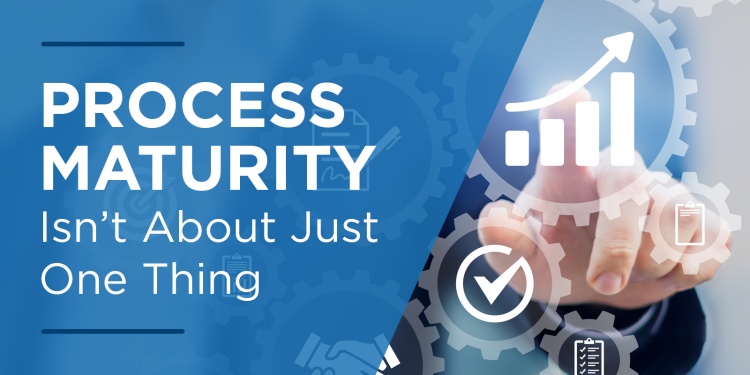
Recently a question has arisen about the difference between business process management (BPM) maturity and process maturity? And do they use the same domains or elements to measure health and maturity?
In previous blogs, we discussed the Seven Tenet of Process Management, which focuses on BPM maturity and ensuring BPM teams provide sustainable value. This falls in what we refer to as “above the flow” process work. Tenets such as strategic alignment, change management, and governance ensures that BPM team efforts support the organization's strategy and goals.
While these underpinning elements for program success are invaluable, the same criteria cannot be used to manage what can be referred to as the “in the flow” maturity of the individual processes of the organization. While there is some overlap in criteria, process maturity requires a different model with a distinct set of domains and maturity levels to assess processes.
Process Knowledge
Process knowledge includes all the assets (people, expertise, and content) required to execute a business process. Hence, this domain expands upon traditional process documentation concepts to also encompass accessibility, training, subject matter expertise, and communities.
What Mature Looks Like
In mature processes, information is pushed or targeted to individuals based on their roles. Subject matter experts are identified, documented, and accessible. Process knowledge documentation includes information relative to the number of reviews/audits it has undergone; as well its variations (e.g., localization and customization) of the process documentation. The documentation also includes communication workflows (e.g., subscriptions to changes), and integration—such as hyperlinking—with other documentation or reference materials.
Risk
Risk management represents the capability to identify and mitigate circumstances that may adversely affect the performance of a process.
What Mature Looks Like
All relevant risks of the process are identified and there are relevant mitigation plans. This also includes risks associated with people (staff, suppliers, and consumers), process inputs (their timeliness, completeness, and quality), and the enabling capabilities of the process (e.g., policies, standards, and regulatory environment).
Tools and Technology
Tools and technology enable capabilities and scalability that would be otherwise economically infeasible. However, if the organization uses ad hoc or inconsistent toolsets, the process’ maturity tends to be much lower.
What Mature Looks Like
The process includes automated process measurement and reporting tools, typically in conjunction with workflow or other automation. In many cases, mature organizations will leverage tools to automate business processes, resulting in advanced services-oriented architecture and systems integration capabilities.
End-to-End Process Integration
End-to-end processes are comprised of multiple sub-processes. The degree of integration between the sub-processes and the end-to-end process, and among the sub-processes is a good indicator of the maturity of a business process. What this means is that the process is assessed and improved within the context of how it affects the other processes (upstream and downstream) and the overarching goals of the end-to-end process.
What Mature Looks Like
The process is well integrated with its relevant end-to-end process and other sub-processes. This means there is clarity on how the process provides value and that the overall goals of the end-to-end are considered and when changes are implemented, they are complimentary and incorporated into end-to-end processes.
Process Performance
Process performance is intended to measure the performance of the process through a few performance measures, including adoption and usability of the process, and its efficiency and effectiveness.
What Mature Looks Like
The process includes clarity around the roles and other processes that depend upon it. It incorporates customer needs and requirements and meets those needs within time and cost constraints. It will also consistently meet both effectiveness and efficiency goals.
Roles and Responsibilities
Processes are executed by people or systems. The relationship of the person or system is defined by their role in relation to the process. Typically, the role has two key characteristics:
- definition – if the role is clearly defined or not and includes the name, responsibilities, and necessary skills.
- capability – if the assigned system or person has the skill or ability needed to perform the assigned role in an efficient and effective manner.
What Mature Looks Like
The process clearly identifies, documents, and communicates the needs and responsibilities of each process role. It regularly monitors the role’s capacity to ensure efficiency and effectiveness and informs the process owner to create remediation actions as necessary.
Measures
Process measures refer to the embedded capability of measurement rather than the process’ actual performance. This includes what measures are fit for purpose (e.g., cost, cycle time, efficiency, effectiveness, productivity, and value) and how the measures are identified and embedded in process and management systems.
What Mature Looks Like
The process will have a good mix of identified measures related to the value that the process provides or key improvement areas. Or it will have measures that align with how the process’ output impacts the outcome of a specific customer need.
For detailed information on calculating a process maturity score and identifying improvement opportunities, check out: Process Audits: Use a Process Maturity Model Report.
For more process and performance management research and insights, follow me on Twitter at @hlykehogland or connect with me on LinkedIn.